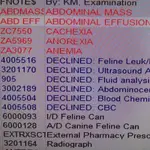3 Ways Great Medical Records Can Protect Your License

It’s a scenario that gives us nightmares: A case has a poor outcome; the owners, angry, file a complaint with the state board; and the board requests a copy of your medical record. You know you did everything right, but how can you be sure that your medical record will protect your license?
Medical records are legal documents that will best protect your license when a complaint is filed. Whether yours is a paper or electronic record-keeping system, these 3 tips will help you create and maintain high-quality medical records.
A good medical record details every aspect of a case.
1. Be thoroughA good medical record details every aspect of a case. Document and discuss everything you do. Others should be able to understand what work was done and conversations discussed in order to pick up where you left off.
The key components of a good medical record include:
Identifying details about the patient (eg, name, age, sex, markings, tattoo, microchip number)
Client information (eg, name, address, contact information)
Presenting complaint(s)
Patient history, with all medications and supplements (prescription or not)
Physical examination findings, including normal findings
Diagnostic recommendations
Treatment provided
Prognosis, if indicated
Written and oral client communication
Educational materials given to clients
Most veterinarians document examination findings and treatment plans, but many could do better in documenting conversations—both face-to-face and via telephone—about differential diagnoses, zoonosis concerns, and potential risks and adverse effects of treatments or procedures.
As the saying goes, “If it is not in the medical record, it never happened.” If you discussed the zoonotic potential of leptospirosis with your client, but it is not documented in the medical record—from a legal perspective—it might as well not have happened.

2. Be inclusiveIn most cases, clients must make decisions about recommended treatments or diagnostic tests. It is just as important to document recommendations they chose to decline as it is to document recommendations they choose to accept. With many electronic management programs, it is easy to mark an item as declined (Figure 1).
It is also important to document any course of action not recommended but elected by the client, such as discontinuing a prescribed medication or treatment or taking the pet home from the hospital against the veterinarian’s recommendations.
3. Be consistentEvery medical record should follow a similar format:
It should be legible
It should be easy to identify who made each entry and when
A quality medical record documents your high level of care for the patient and client.
Each practice should document and explain all abbreviations used in records; or, consider following the American Animal Hospital Association Standard Abbreviations for Veterinary Medical Records for abbreviations.
Records should be completed in a timely manner. Any additions should be recorded as a dated addendum rather than adjusting the initial entry. Electronic medical records offer many advantages, including password protection of all entries, a record of the time and date, and protection against altering a record after a set period of time. 1
A quality medical record documents your high level of care for the patient and client. A clear, concise, complete medical record is the best protection against a complaint to the state board. Generating good medical records on a daily basis can help eliminate the fear of being contacted by the state board and allow you to focus on what’s most important―providing the best possible care to your patients.
Reference
1. Law and Ethics of the Veterinary Profession. Wilson JF―Indianapolis: Priority Press, 1990.